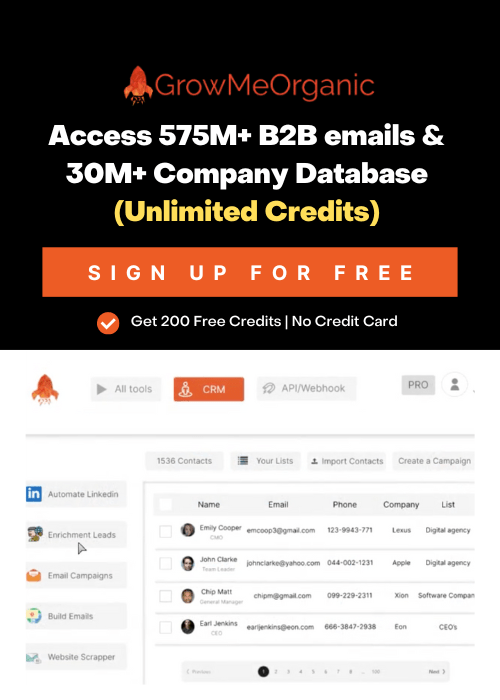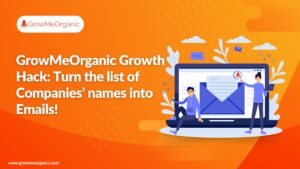Thanks to email, you can connect with clients across the globe in minutes. With over 7.9 billion email addresses worldwide, the potential for businesses to reach new audiences is massive.
Over 40% of B2B marketers say email is the key to marketing success, and 80% of business professionals rely on it to keep customers returning.
When used effectively, email becomes a powerful tool for building lasting, profitable customer relationships – especially for small businesses.
As a small business owner, you’re juggling everything—products, marketing, and more—often without much help. Time and budget constraints can make finding the best way to grow your business challenging.
If you’ve ever wondered if there’s a smarter way to generate leads, the answer is email marketing. But it can feel overwhelming: building a list, nurturing leads, setting up a strategy, and choosing the right email platform.
That’s why we’ve created this all-in-one guide to help you use email marketing effortlessly. Let’s get started!
Why Is Email Marketing Important?
Here’s why email marketing is essential for businesses, be it small or big:
Cost-Efficient Marketing Strategy
Email marketing offers a cost-effective way to reach your audience.
You can engage a large audience without overspending with minimal design and distribution expenses. It’s more affordable than traditional advertising, and the ROI is impressive.
More Targeted and Personalized Communication
Email marketing is all about sending the right message to the right people.
By grouping your subscribers based on demographics, behavior, or preferences, you can tailor your messages to be more relevant.
In fact, 76% of buyers expect personalized content to build a better relationship with brands, and 83% are willing to share their data for a more personalized experience.
Something as simple as using a customer’s name or referencing a past interaction shows that you’re paying attention.
Better Customer Relationships
Email marketing is a direct line to your customers. By sending regular newsletters, exclusive offers, and personalized updates, you can build stronger relationships right in their inboxes.
According to Databox, about 45% of marketers send weekly emails. This kind of consistent outreach helps build trust and loyalty and keeps your brand at the top of their mind.
Measurable and Trackable Results
One of email marketing’s biggest strengths is its ease of measurement. Using detailed analytics tools, you can track everything—open rates, clicks, and conversions.
This allows businesses to assess how their email campaigns are performing. By diving into these insights, marketers can tweak their strategies and optimize future campaigns.
Sales and Conversions
An effective email campaign helps businesses smoothly move leads through the sales funnel. You can drive real conversions with a smart sequence and strong calls to action.
Take Landcafe.pl, an online store for artisanal coffee beans. They wanted to boost brand awareness and motivate subscribers to purchase their products. They launched an educational email series and saw impressive results.
Brand Awareness and Reach
Email marketing boosts your brand’s visibility and helps reach a global audience.
A well-crafted series of three welcome emails can make a big difference, driving 90% more orders than just one email. These welcome emails also outperform standard campaigns, with four times higher open rates and five times better click-through rates.
“Introductory email marketing tactics for small businesses include creating a mailing list, choosing an email service provider, designing a lead magnet to entice subscribers, and crafting a personalized welcome email to introduce your business and its offerings. Personalization, segmentation, and offer-based email campaigns are also effective strategies to build engagement and loyalty with your audience.”
– Prachee Dawedar Quora User.
Four Easy Steps to Launch Your Small Business Strategy

A successful email marketing strategy consists of four main components:
- Creating and Maintaining an email list.
- Emails must be sent in the right format.
- Content creation and email design.
- Launching the campaign and analyzing the results.
Creating And Maintaining An Email List
Creating a contact list is the first step to sending email marketing campaigns.
Your website, blog, and social media sites are great places to place a signup form. The best way to ensure success is to set up a double-opt-in signup form.
Double opt-in signup forms send new subscribers a confirmation email upon submitting their email address. The benefits of double opt-in include:
- Allow your subscribers to ask them what kind of content they would like to receive.
- Ensure that email addresses are not typographically incorrect.
Consider placing or linking to your sign-up forms on your homepage, blog, social media profiles, and even in your email signature.
Select The Types Of Email You Wish To Send
After you develop a strategy for growing your email list, choose the type of emails you want to send.
Depending on your small business type, you can send different types of emails. Sending a monthly email newsletter is a good start. Here are some other examples:
- Promotional emails for sales and special offers.
- Holiday or special event emails.
- Customized discounts and coupons for your most loyal customers.
- Emails related to transactions (e-commerce receipts, appointment reminders, etc.)
Design Your Email And Write The Content
Designing and writing email content helps build an effective small business email marketing campaign. For email design, simplicity is crucial—your designs should align with your brand and avoid overly complex elements.
A clear and relevant call to action (CTA) should be included, but avoid multiple CTAs to prevent overwhelming your audience. You can also enhance your emails by adding QR codes for optimal engagement.
When writing content, focus on your subscribers’ interests. Segmenting your email list based on factors like demographics or purchasing history allows for more personalized and targeted messaging.
Analyze The Performance Of Your Campaign
Analyzing your campaigns’ performance maximizes your marketing efforts. Email offers more data and statistics than other digital marketing channels. Monitor metrics like open rate, click-through rate, and conversion rate and make necessary adjustments for the best results.
Tips For Small Businesses Using Email Marketing In 2025
Want to elevate your campaigns from good to great? It all comes down to the right strategies. Here are some tips to help you create campaigns that truly resonate and deliver results.
1. Segmentation and Personalization – Segmentation allows small businesses to divide their subscriber lists into targeted groups based on demographics, behaviors, or purchase history.
This enables you to create personalized content that resonates, boosting sign-ups, subscriptions, or sales conversions. For businesses with limited resources, this focused approach is essential for building a loyal customer base.
“I think if you’re just starting out, and especially if you’re a solo owner, than writing things more personally and sharing behind-the-scenes type content is potentially a GREAT way to connect with your audience and build trust/engagement.”
– Zirconst Reddit User
2. Sending Emails at the Right Time – Timing is crucial in whether your subscribers open and engage with your emails. By sending your emails when your audience is most active – during certain hours or specific days – you boost the chances of getting more interactions.
So, when is the best time to hit “send”? Take some time to understand your audience’s behavior patterns, preferences, and time zones.
3. Compelling Subject Lines – First impressions are everything, especially in email marketing. A compelling subject line can be the deciding factor in whether your email gets opened or ignored.
So, what makes a subject line engaging? It could be a thought-provoking question, a surprising statistic from your industry, or even a nod to a trending news story.
4. Images with Alt Text – Alt text is a helpful description of an image, primarily for readers with visual impairments or those using assistive technologies.
Sometimes, email clients may block images from loading, so your photos might not appear. However, with alt text, you ensure that a textual description is displayed instead, keeping your message clear.
5. Clear Call to Action (CTA) – A strong call to action (CTA) is essential for guiding readers toward the next step, whether it’s making a purchase or signing up for a service.
Define your email’s goal and emphasize its value to motivate clicks. Use concise, impactful phrases like “Shop Now” and ensure your CTA stands out visually for better results.
6. Automated Email Marketing Campaigns – Staying ahead in email marketing—whether in copy, design, or analytics—can be tricky. That’s where automation can be a game changer.
With a solid email marketing automation tool, you can send emails triggered by user behavior or set timelines. This frees you up to concentrate on crafting your strategy and content. Plus, automated email sequences mean your subscribers get messages exactly when they need them.
7. Social Sharing Buttons – Social sharing buttons let subscribers effortlessly share their emails across their favorite social networks. This feature breaks through the inbox barrier and helps you connect with a wider audience.
When your subscribers share your content, it boosts your credibility. After all, recommendations from friends and connections hold more influence because they come from trusted sources.
8. Mobile-Optimized Emails – With billions of mobile users worldwide, optimizing your emails for mobile is crucial in today’s digital landscape. Start using a responsive design that adjusts to different screen sizes, featuring a single-column layout and larger font for readability.
Keep content concise and easy to scan, utilizing short paragraphs and bullet points. Use an AI image generator to create engaging visuals, ensure images are compressed for faster loading, and make call-to-action buttons large and spaced for easy tapping. Test emails across multiple devices to guarantee compatibility.
9. Analytics and Optimization – Email marketing metrics help you understand your audience and optimize your campaigns. By analyzing these metrics, you can tailor your personalization and segmentation strategies, allowing for hyper-targeted campaigns that align with customer needs.
Key metrics include the open rate, which measures how many recipients opened your email (ideally 17% to 28%); the click-through rate (CTR), indicating how many clicked links within your email (2% to 5% is good); and the conversion rate, reflecting completed desired actions (also 2% to 5%).
10. A/B Test Emails – By comparing different email versions, you can discover what boosts open rates, click-through rates, and conversions. Test elements like sender name, subject line, email copy, images, layout, CTAs, and send times to maximize your impact.

Final Thoughts
“Email marketing would work but you would have to be committed to the process. You’d have to send an email or two weekly to make sure your list doesn’t go stale. Most email communications are forgotten about in 48 hours so don’t be afraid to send a bunch.”
– GermBlaster76, Reddit User.
Building an email marketing plan can be tough for small businesses, especially if it’s your first time. But once you discover the right tools, you’ll be amazed at the opportunities email marketing can bring for your ROI and business growth.
And don’t forget, GrowMeOrganic is here to help you begin things smoothly. It is a cold email tool that helps you send highly personalized emails with automatic follow-ups. Find valid email addresses, create tailored outreach templates, send targeted emails, and track your performance—all in one place.
Sign up for a free account today and explore our unique features!
FAQs
Q 1. How Do I Set Up Email Marketing For My Small Business?
To set up email marketing for your small business, choose an email marketing platform like GrowMeOrganic and create an account. Build your email list by collecting subscriber information through sign-up forms on your website and social media, then design and send your first campaign.
Q 2. Does Email Marketing Work For Small Businesses?
Yes, email marketing is effective for small businesses. It helps build relationships with your audience, promote products or services, and drive sales—all at a relatively low cost. You can engage customers directly with targeted campaigns and achieve a strong ROI.
Q 3. What Are The Different Types Of Email Marketing?
Email marketing comes in several forms, including newsletters for updates and engagement, promotional emails to highlight offers, transactional emails for confirmations and receipts, and targeted campaigns tailored to specific audience segments.
Q 4. How Do I Start Email Marketing As A Beginner?
To start email marketing as a beginner, choose an email marketing platform like GrowMeOrganic to create and manage your campaigns. Build a targeted email list, craft engaging content, and send regular newsletters or promotions to connect with your audience effectively.
About Post Author
Anant Gupta
Growth Hacker, Marketing Automation Enthusiast & Founder of GrowMeOrganic







